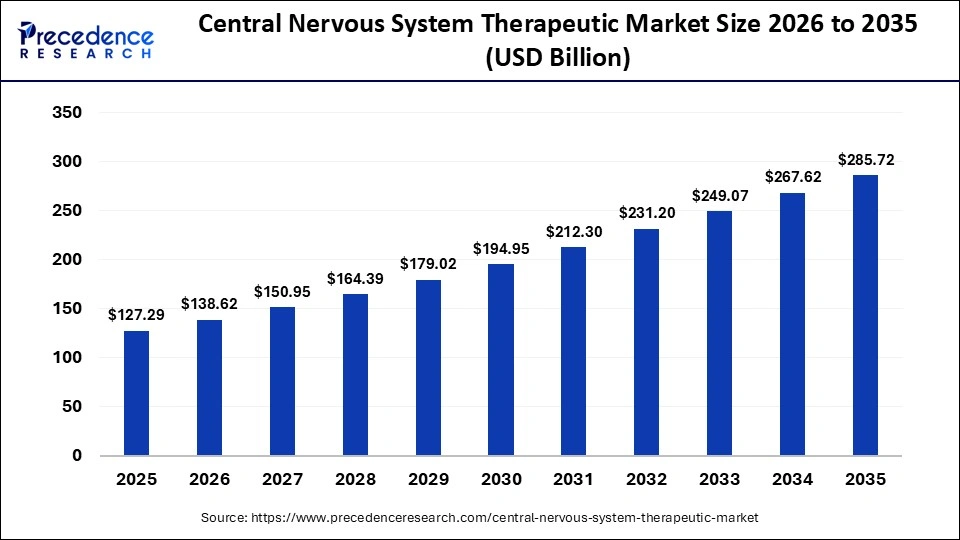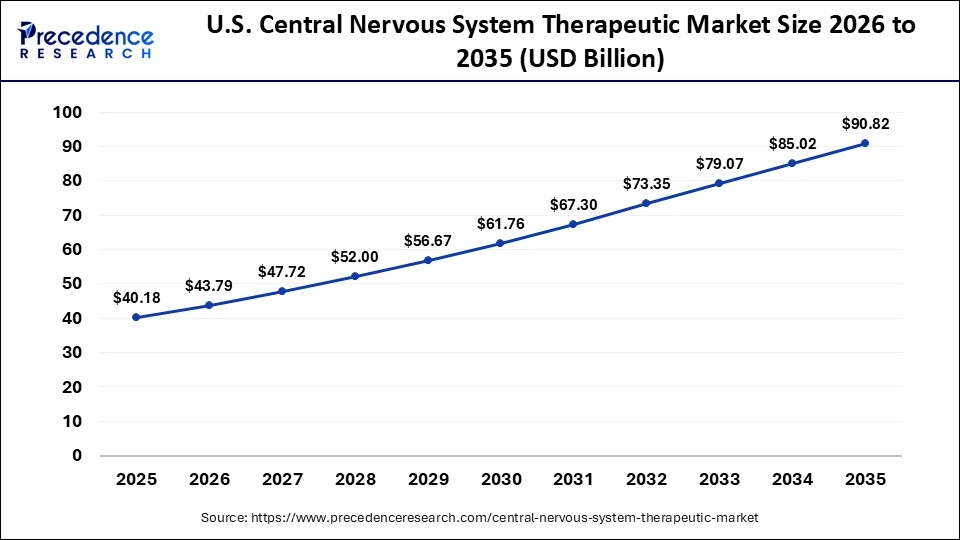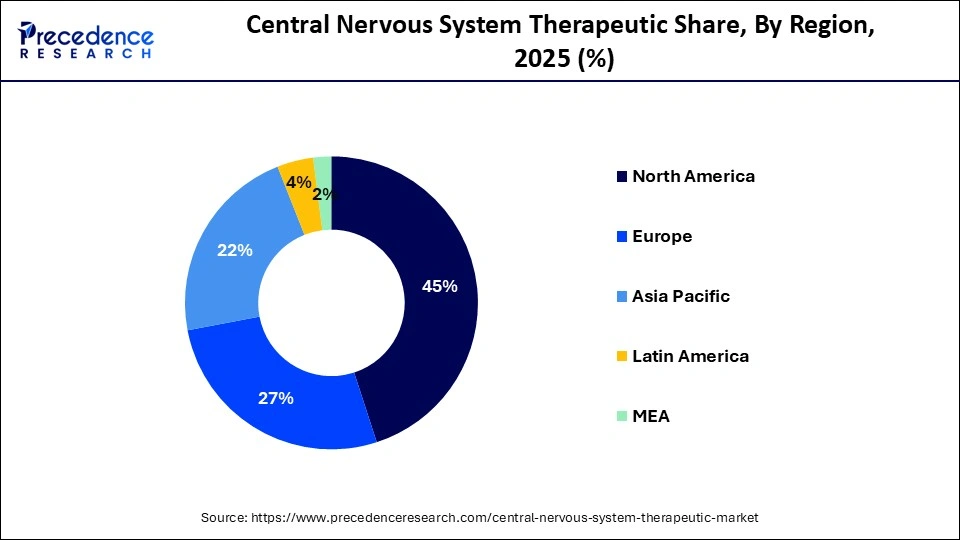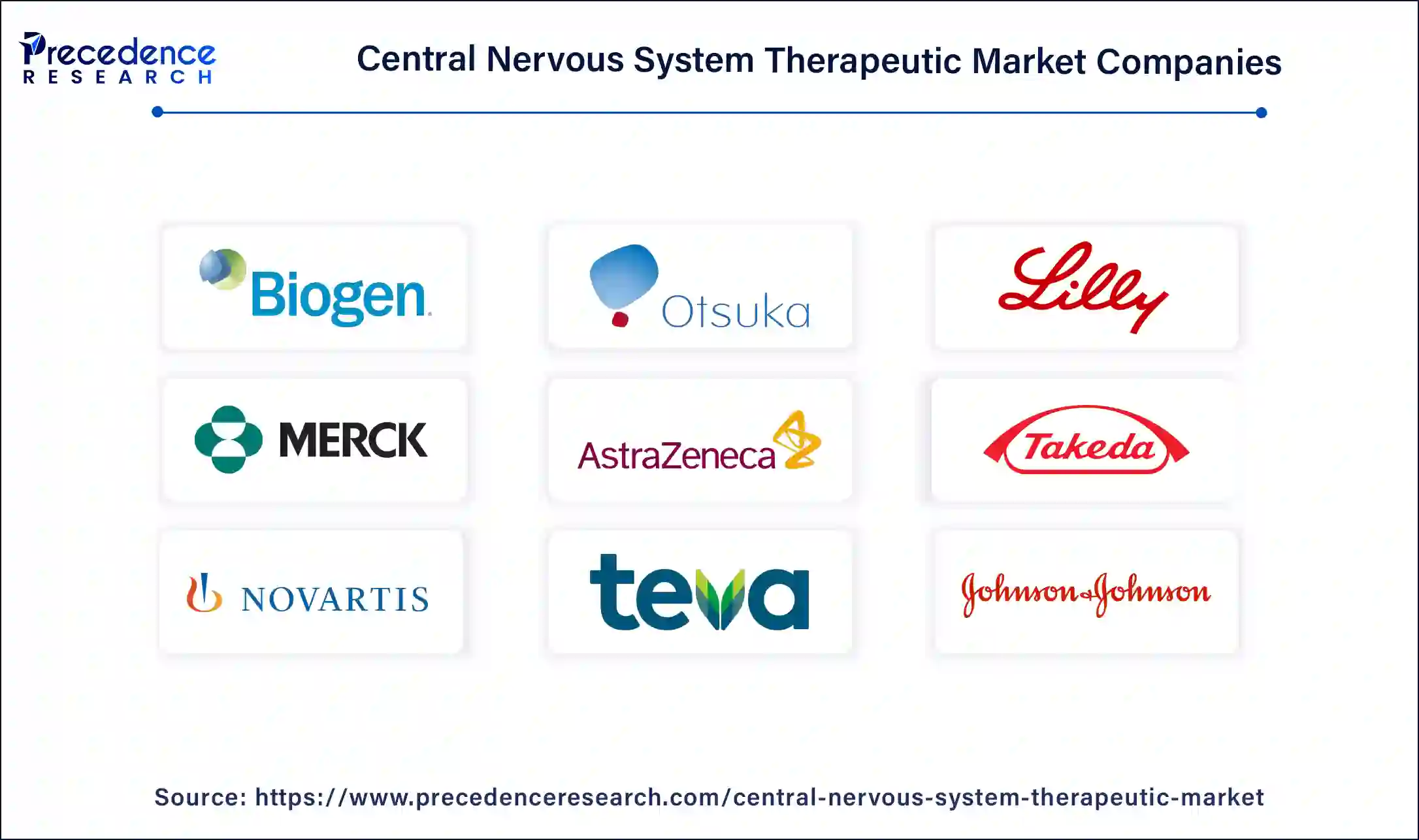List of Contents
What is the Central Nervous System Therapeutic Market Size?
The global central nervous system therapeutics market size accounted for USD 127.29 billion in 2025 and predicted to increase from USD 138.62 billion in 2026 to approximately USD 285.72 billion by 2025, growing at a CAGR of 8.64% from 2026 to 2035.

Market Highlights
- North America dominated the market with the largest market share of 45 % in 2025.
- By disease, the neurodegenerative diseases segment contributed more than 40% of market share in 2025.
- By disease, the CNS cancer segment is expected to grow rapidly in the market during the forecast period.
Market Size and Forecast
- Market Size in 2025: USD 127.29 Billion
- Market Size in 2026: USD 138.62 Billion
- Forecasted Market Size by 2034: USD 267.62 Billion
- CAGR (2025-2034): 8.64%
- Largest Market in 2024: North America
How AI is evolving the central nervous system therapeutic sector?
The artificial intelligence is revolutionizing CNS therapeutics through fast-tracking drug discovery, improving diagnostics, and optimizing clinical trials. It analyzes multi-omics datasets to study disease mechanisms, to design drugs, to repurpose drugs, predict their efficacy, toxicity, and ADME properties, among others. It redefines precision medicine by customizing therapies for patient-specific genetic and lifestyle developments. It facilitates early diagnosis for CNS disorders through biomarker and imaging analyses, giving treatment outcome recommendations accordingly. Clinical trial recruitment, adaptive design, and real-time monitoring are the areas AI empowers to enhance efficiency and safety.
Central Nervous System Therapeutic Market Growth Factors
An increase in the prevalence of central nervous system diseases is fueling the demand for the advanced therapeutics across the globe. Advancements in the therapeutics and diagnostics of the central nervous system disorders is expected to drive the growth of the global central nervous system therapeutic market. According to the World Health Organization, the central nervous system diseases such as Parkinson's disease, Alzheimer's disease, epilepsy, stroke, and multiple sclerosis affects around 1 billion people across the globe. The increasing prevalence of such CNS disorder has encouraged the pharmaceutical companies to invest heavily in the development of the novel therapies for curing the CNS disorders. The patent expiration has resulted in the approvals of generic products like Invega and Copaxone that has increased the treatment rates in the low and middle income economies. For example, the US FDA has approved two generic types of Copaxone in 2018. The rising investments in the new drug developments and clinical trials are facilitating the entry of new therapeutics in the global CNS therapeutic market. The government regulations and the concerned authorities like EMA and FDA are taking an active part in monitoring the results of clinical trials and approvals of the CNS therapeutics.
The development of new therapeutics for the treatment of the central nervous system disorders has led to the development of the innovative drug delivery devices. The development of these innovative drug delivery devices is expected to augment the growth of the central nervous system therapeutic market. The advanced therapeutics and drug delivery devices have low or no side effects. The availability of well-built pipeline products along with the easy availability of therapeutics is propelling the market growth. Moreover, the rising awareness among the population regarding the neurodegenerative disorders and mental health is expected to have a significant effect on the demand for the central nervous system therapeutics across the globe. The increasing efforts of the government and non-government organizations like World Health Organization that conducts awareness programs regarding the various mental disorders, are playing a crucial role in the development of the CNS therapeutic market.For instance, the Spanish government is taking efforts to spread awareness regarding the dementia and promotes research activities in the country. The growing geriatric population coupled with the rising prevalence of Alzheimer's disease among them is fueling the growth of the CNS therapeutic market. As per the Alzheimer's Association, over 5million people are affected with the Alzheimer's diseases and this number is projected to reach 14 million by 2050.
- The soaring incidence of CNS disorders like Alzheimer's, Parkinson's, epilepsy, stroke, and multiple sclerosis is having adverse effects on almost 1 billion individuals worldwide.
- Things have been changing therapeutics and diagnostics with new commercial drug delivery devices that promise efficacy and lower side effects.
- Patent expiration and other generics related matters (Copaxone and Invega, for example) are increasing treatment access and rates in low- and middle-income economies.
- Strong pipeline and growing R&D investments with active support from regulatory bodies like FDA and EMA for clinical trials and approvals have fueled the growth.
- Increasing awareness and an aging population; government and NGOs' efforts toward mental health awareness, coupled with rising Alzheimer's cases, are driving demand in the market.
Central Nervous System Therapeutic Market Outlook
The growing prevalence affecting the CNS and the need for precision treatment and care attract many relevant fields of technological advancement to thrive in the CNS therapeutic market. The modern treatment and healthtech focusing on precision has bolstered the business of the smart minds, bringing positive impact and accurate care to the market's challenging areas.
The CNS therapeutic market is witnessing prominent growth and is further characterised by accelerating rates of neurodegenerative and mental health disorders. The market is driven by advances in delivery techniques such as gene therapy and nanomedicines.
Market Scope
| Report Coverage | Details |
| Market Size in 2025 | USD 127.29 Billion |
| Market Size in 2026 | USD 138.62 Billion |
| Market Size by 2035 | USD 285.72 Billion |
| Market Growth Rate from 2026 to 2035 | CAGR of 8.64% |
| Largest Market | North America |
| Base Year | 2025 |
| Forecast Period | 2026 to 2035 |
| Segments Covered | Disease Type, Region |
| Regions Covered | North America, Europe, Asia-Pacific, Latin America, and Middle East & Africa |
Market Dynamics
Drivers
Increased Awareness and Accessibility
Enhanced accessibility and rising awareness are considered to be major drivers of the CNS therapeutics market. There are increased campaigns in mental health awareness that aim at reducing stigma so that people can be timely in seeking diagnosis and treatment of conditions such as depression, anxiety, and neurodegenerative disorders. Telehealth and telemedicine adoption have closed down accessibility gaps, especiallyfor patients located in remote areas or underserved, providing them a more convenient time of consulting specialists. Additional government support in terms of policy, funding, and healthcare reforms are increasing CNS treatment and research access so that more patients get early intervention and advanced treatment options.
Restraint
Limited Treatment Options and Generic Competition
Despite all the advancements, the CNS therapeutics market presently faces restraints, mainly headed by the limited treatment possibilities in various neurological disorders such as Alzheimer's and Parkinson's, where curative therapies do not exist. Most treatment modalities are only symptomatic and do not tackle root causes. In furtherance, with many key drugs going off-patent, garnering a slew of generic alternatives is on the cards. While generics do bring down prices and make drugs affordable, their presence puts a price squeeze on branded drugs, thereby hitting profitability and discouraging their investment in longer-term R&D. This combination of limited therapeutic innovation and competitive pricing continues to pose barriers for the market to realize its complete potential growth, thereby furnishing a challenge to pharmaceutical companies.
Opportunity
Advancements in Therapeutics
Therapeutic interventions present a critical avenue for growth in the CNS market. A biological agent, monoclonal antibody, and gene therapy breakthroughs have shifted from symptom management toward disease-modifying treatments. New drug delivery systems and precision medicine ensure the safety, efficacy, and patient compliance of treatments. Neurogenomics and biomarker research have rapidly advanced to allow targeted and individualized therapies. A majority of these innovations, being lucrative developments, are backed by investments from pharmaceutical industries and biotech companies, government funding, and regulatory favors. Hence, these cutting-edge therapeutics are expected to offer further expansion to the territory of CNS-related treatment.
Central Nervous System Therapeutic Market Segment Insights
Disease Insights
The neurodegenerative diseases segment accounted for a market share of around 40% and dominated the global central nervous system therapeutic market in 2025. The rising incidences of neurodegenerative diseases such as Parkinson's disease, Alzheimer's disease, and multiple sclerosis among the population have driven the growth of this segment. According to the Alzheimer's Association, around 14 million people will be suffering from Alzheimer's disease by 2050 across the globe. According to the Parkinson's Foundation, over 10 million people across the globe are living with Parkinson's disease. Moreover, the prevalence of Parkinson's disease increases with the aging. The presence of the well-built pipeline therapeutics for the treatment of the Parkinson's disease and other neurodegenerative disease has fostered the growth of the neurodegenerative segment in the past few years.
The mental health segment was the second leading segment in the global central nervous system therapeutic market. This is attributed to the rising prevalence of anxiety disorders, epilepsy, and psychotic disorders. The easy availability of drugs and increased awareness regarding mental health has augmented the growth of this segment in the global market.
The CNS cancer is estimated to be the most opportunistic segment during the forecast period. The rising prevalence of CNS cancer and growing demand for the therapeutics is boosting the growth. Around 300,000 people were diagnosed with brain cancer across the globe in 2018 around 240,000 people died in the same year due to it. The higher mortality rates has attracted a huge investments in the research and development of the therapeutics for the CNS cancer treatment, which is expected to drive the growth of this segment in the foreseeable future.
Central Nervous System Therapeutic Market Regional Insights
The U.S. central nervous system therapeutics market size is valued at USD 40.18 billion in 2025 and is epected to be worth around USD 85.02 billion by 2034, at a CAGR of 8.71% from 2026 to 2035.

North America dominated the global central nervous system therapeutic market, garnering a market share of over 45% in 2025. The increased prevalence of neurodegenerative disorders and other CNS diseases in US has resulted in the huge demand for the CNS therapeutics. Around 70,800 people are affected with brain cancer every year in the US, which causes 2.4% of the total cancer deaths in US. Moreover, as per the Parkinson's Foundation, about 60,000 people are diagnosed with Parkinson's disease in US each year and around 1 million people are living with Parkinson's disease in US. Moreover, the presence of several top players and the increased investments by them for the development of novel therapies are significantly influencing the market growth in this region. Furthermore, the increased awareness among the people regarding the mental health and the presence of strong pipeline products in North America has exponential contributions in the growth of the central nervous system therapeutic market.

On the other hand, Asia Pacific is estimated to be the most opportunistic market in the forthcoming years. The rising government investments in improvement of the healthcare infrastructure along with the presence of huge patients with unfulfilled medical needs are the major market drivers. The non-profit organizations are playing an exceptional role in providing free of cost treatments for the central nervous system diseases and spreading the awareness regarding the mental health and CNS therapeutics. These factors are expected to drive the growth of the Asia Pacific central nervous system therapeutic market during the forecast period.
Europe has made an effective and long-sustained contribution in the market via the foundational scientific exploratories, and the development of the key innovative new medicines, exponential private and public funding and new research institutions bringing solutions to the challenging ground of discussion. The European scientists were fundamental to the development of basic steps of learning new advances, changes or challenges of the brain and nervous system.
The robust discoveries stimulating the contribution of this region focused on Neurotransmission, disease identification, brain function and neuroanatomy. Along with the support of research funding and institutions, the region succeeds in delivering excellence to the central nervous system therapeutic market.
The region is making an empowering shift with its advancement in CNS therapeutic via comprehensive genetic studies, international partnerships and the development of the regional research infrastructure, such as brain banks. The researchers of this region play a major role in adopting advancements across the huge spectrum of the region. The researchers are unifying advanced technologies involving popular AI, especially for VR, spatial transcriptomics and automated neuropathological analysis for public outreach and neuroeducation, boosting awareness.
Central Nervous System Therapeutic Market Value Chain Analysis
The analysis of operations and manufacturing involves supply chain management, visibility, lean manufacturing, process refinement, and quality control and compliance. To address inefficiency in production and manufacturing processes is necessary to alleviate cost without sacrificing quality and rigorous regulatory standards needed for CNS drugs.
The distribution and marketing analysis calculates specialised logistics (cold chain), sales and marketing in an expert field and market access and pricing strategies to accelerate the CNS therapeutic market. The adherence and patient support programs also balance the analysis.
The integration of applications like big data and AI in the R&D process has leveraged the drug development analysis. The translational science potency and animal models improve the predictability of precision preclinical research. Diagnostic tool development has also stimulated the CNS therapeutic market.
Central Nervous System Therapeutic Market Companies

- Biogen Inc.
- Otsuka Pharmaceutical Co. Ltd
- Eli Lilly and Company
- Merck & Co.
- AstraZeneca
- Takeda Pharmaceutical Company Limited
- Novartis AG
- Teva Pharmaceutical Industries Ltd.
- Johnson & Johnson Private Limited
- Pfizer Inc.
- GlaxoSmithKline PLC
Recent Developments
- In May 2025, Coave Therapeutics officially launched its vector, coAAV-CSF-01, at ASGCT 2025. The vector enhances CNS transduction and safety in Cynomolgus macaques, a non-human primate, following intra-cerebrospinal fluid administration. (Source: https://www.biopharminternational.com)
- In May 2025, Biogen and City Therapeutics have announced a strategic collaboration to develop novel RNAi therapies. (Source: https://investors.biogen.com)
- In February 2020, Biogen and Sangamo Therapeutics entered into a deal of US$2.7 billion for developing a gene regulation therapy for the treatment of Alzheimer's disease.
- In April 2021, Biogen acquired the approval of National Medical Products Administration for its product TECFIDERA for the treatment of relapsing multiple sclerosis in China.
The key market players are constantly engaged in various developmental strategies such as product launches, collaborations, and partnerships in order to establish their supremacy in the market and gain competitive edge over others. These developmental strategies are expected to provide new growth prospects in the forthcoming future and will foster the growth of the global central nervous system therapeutic market.
Central Nervous System Therapeutic Market Segments Covered in the Report
By Disease
- Neurovascular Diseases
- Mental Health
- Anxiety Disorders
- Mood Disorders
- Epilepsy
- Psychotic Disorders
- Others
- Neurodegenerative Diseases
- Parkinson�s Disease
- Alzheimer�s Disease
- Amyotrophic Lateral Sclerosis
- Multiple Sclerosis
- Huntington�s Disease
- Others
- CNS Trauma
- CNS Cancer
- Infectious Diseases
- Others
By Region
- North America
- Europe
- Asia-pacific
- Latin America
- Middle and East Africa
For inquiries regarding discounts, bulk purchases, or customization requests, please contact us at sales@precedenceresearch.com
Frequently Asked Questions
Ask For Sample
No cookie-cutter, only authentic analysis – take the 1st step to become a Precedence Research client